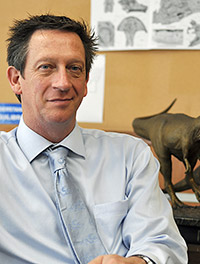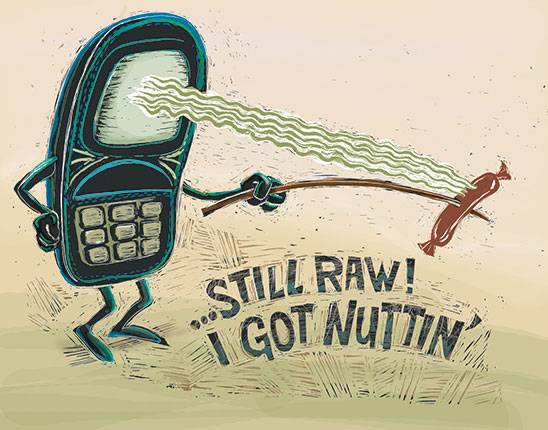
Do Cell Phones Cause Cancer?
by Bernard Leikind
Microwave radiation from cell phones cannot cause cancer by any mechanism, known or unknown. My answer to the question in the title of this essay is… Fuggedaboudit! No way! When pigs fly! When I’m the Pope! In short, No!
This essay is a companion to my article of the same title that appears in Skeptic magazine Vol. 15, no. 4, out on newsstands and in bookstores this week. Here I present the shortened non-technical version, and describe what all physicists know to be true about what happens when human tissue or any material absorbs microwave radiation. It is this knowledge that leads me to assert with such vehemence that cell phones do not cause cancer. I will also consider two recent, major epidemiological studies from Europe that correctly showed that there was no relationship between cell phones and brain cancers.
A cell phone emits about 1 Watt of electromagnetic radiation. Most of that zooms away to find a cell phone tower. The tissues of the user will absorb a part of this radiation. These tissues include the caller’s hand, ear, scalp, skull, and brain. The closer a tissue is to the cell phone’s antenna, the more of the radiation the tissue absorbs. For some reason, however, none of those raising fears about cell phones causing cancer are concerned about skin cancers on palms, fingers, or ears.
The frequency of the typical cell phone radiation is about 2.5 GHz, two and a half billion flips back and forth per second. The radiation travels at the speed of light — 186,000 miles per second — and dividing the one by the other and correcting for the units I used for the speed, shows that the wavelength of this radiation is about 10 centimeters or about 4 inches.
As the electric fields of the waves pass through the body’s tissues, the fields grab and try to shake any molecules or parts of the molecules that they can. These fields like to grab and shake water molecules, and there are plenty available. The fields will grab whatever else they can, which may be all or of parts of many of the critical molecules of biochemistry, such as the DNA in genes, or enzymes, fuel molecules, waste molecules, structural molecules, and so on.
All of these molecules exist within the cytoplasm, and they are in close touch with one another. The molecules are quivering, twisting, and shaking, rattling about and transferring energy between each other. During the time — less than one billionth of a second — that it would take the cell phone’s radiation to shake a molecule or part of a molecule back and forth, that molecule will suffer a thousand or ten thousand collisions with its neighbors. Any energy that the one molecule might begin to gather from the electromagnetic field rapidly spreads throughout all of its neighbors.
Coursing nearby to these molecules is a capillary filled with blood plasma and blood cells. This blood is at body temperature. Any extra energy from any source that appears in cells close to the capillaries will transfer into the slightly cooler blood, warming it. The flowing blood will carry the energy throughout the body. The body temperature will increase imperceptibly, and the extra energy will eventually transfer from the skin into the environment.
Anyone who puts forward a potential mechanism by which this energy flow, less than 1 Watt, might cause any cancer should notice that he has thereby explained too much. One watt is much smaller than many other natural energy flows that no one suspects might cause cancer. In my Skeptic paper, I show that the average energy production in my body as I go about my life is about 100 Watts. I also show that while I jog on my local gym’s treadmill for half an hour, I produce 1100 or 1200 Watts. This energy, produced in my leg muscles, travels throughout my body including my brain, and I sweat a lot. My body’s temperature does not change much. No one believes that my frequent treadmill sessions cause cancer. If the cell phone’s less than 1 Watt causes cancers, then why doesn’t my exercise session’s more than 1000 Watts cause cancer?
Within the past year the results from two major epidemiological studies appeared in the scientific literature and to great fanfare in the media. Plainly stated, these two different kinds of studies found no evidence to link cell phones and brain cancers. The researchers might have simply said, “We did these large, carefully designed studies, and cell phones have nothing to do with brain cancer.”
In the major Danish study, the researchers collected data from the entire populations of Denmark, Sweden, Norway, and Finland. These sensible countries have long provided medical care for all of their fortunate residents. Therefore, the researchers had access to thorough records. Brain cancers are rare, so they must search through large populations to find sufficient cases to draw conclusions. The plan of this study was to compare trends in the incidence of brain cancers from the late 1980s into the mid 1990s when cell phone use was non-existent or rare with the incidence in the first decade of the 21st century when cell phone use was wide spread. They saw no effect. None. Zero. Nada.
These researchers believe that cell phones must cause brain cancer somehow to some degree. Therefore, they asserted that perhaps their study was not large enough, perhaps their study did not cover sufficient time, or perhaps the large sample population diluted the effect in susceptible subgroups. They grudgingly admitted that it was possible that their study showed no effect because cell phones do not cause cancer.
The other study, known as the Interphone study, is a case-control study. Searching the populations of 13 European nations the researchers found 6000 brain cancer patients. Next, the researchers sought out 6000 more people to form a matched control group. Then the epidemiologists searched their data to see if they could detect suggestions that cell phone use might increase the risk of brain cancer. “The results really don’t allow us to conclude that there is any risk associated with mobile phone use, but… it is also premature to say that there is no risk associated with it,” the IARC’s director Christopher Wild told Reuters. Also:
Data from the IARC study showed that overall, mobile telephone users in fact had a lower risk of brain cancer than people who had never used one, but the 21 scientists … said this finding suggested problems with the method, or inaccurate information from those who took part.
Other results showed high cumulative call time may slightly raise the risk, but again the finding was not reliable.
“We can’t just conclude that there is no effect,” said Elisabeth Cardis of the Centre for Research in Environmental Epidemiology in Barcelona, Spain, who led the study.
“There are indications of a possible increase. We’re not sure that it is correct. It could be due to bias, but the indications are sufficiently strong … to be concerned.”
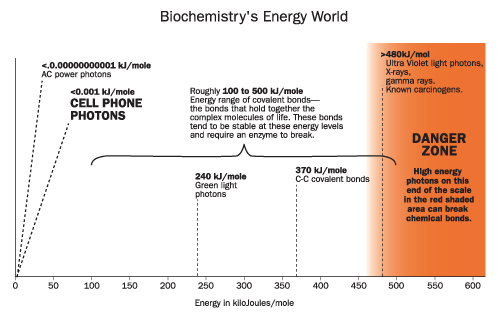
A chart simplified from the printed version of this article in Skeptic magazine Vol. 15, No. 4. This eSkeptic version says that the brain receives only a tiny amount of energy from a cell phone compared to that generated by normal activity such as working out. The body’s powerful temperature control system deals with this extra energy without breaking into a sweat. The Skeptic magazine article compares the energy required to break the chemical bonds in living cells with the energy level of cell phone photons and other forms of electromagnetic energy. The result is the same. Cell phones cannot damage living tissue or cause cancer. (Click the image to download a PDF version of the diagram.)
Why aren’t these researchers proclaiming the brilliant discovery that cell phones protect against brain cancer? Why do they believe that concern is justified? They are confident that there is no possible way for cell phones to reduce the risk of brain cancer, but they suspect that the physicists might be wrong that there is no mechanism.
Physicists have solved the problem of microwave radiation and absorption. We know exactly what happens to the radiation, and there is no fuzzy area about it that we do not understand. The epidemiologists hear instead that physicists do not know of a mechanism by which the radiation might cause cancer.
The epidemiologists explain away their great discovery that cell phones protect against cancer and suspect that they may cause brain cancer because they believe the first has no mechanism and the second may have an unknown one. I argue strongly that there is no possible mechanism, known or unknown, by which cell phone radiation might cause cancer. However, the epidemiologists are wrong that there is no way by which cell phones might reduce the risk of brain cancer.
Here is my proposal. When our brains absorb energy from cell phones, there is a small temperature increase. When our bodies wish to energize our defense systems and to discomfit the bad guys, the immune system raises the temperature. If the problem is local, the innate immune system produces inflammation. If the problem is general, the innate immune system produces fever. Evidently, a slight, but noticeable temperature increase is beneficial to us.
Physicist Bernard Leikind ate a light bulb for an earlier generation of Skeptic readers — Vol. 3 No.3, 1995. He turned off the power, unscrewed the bulb, smashed it with a hammer, and only ate the glass. He strongly advises readers not to eat their cell phones even if they have turned them off, smashed them, and canceled their contracts.
Skeptical perspectives on fear mongering,
fraud and junk science, and plain nonsense
-
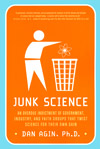 Junk Science
Junk Science
(paperback $14.95) -
In this provocative, wide-ranging, and hard-hitting book, University of Chicago biology professor Dan Agin separates fact from conveniently “scientific” fiction and exposes the data faking, reality ignoring, fear mongering, and outright lying that contribute to intentionally manufactured public ignorance.
Read more…
-
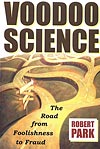 Voodoo Science: the Road from Foolishness to Fraud
Voodoo Science: the Road from Foolishness to Fraud
(paperback $17.95) -
On our top ten list of recommended critical thinking books. Physicist Park expertly analyzes cold fusion, perpetual motion machines, free energy claims, and how well-meaning scientists can go down the wrong road through self-deception. Read more…


NEW ON SKEPTICBLOG.ORG
Children Waiting for the End of the World
Children around the world are stressed and terrified by the idea that the world will end catastrophically in 2012. In this week’s Skepticblog post, Daniel Loxton reminds skeptics that we can help combat the pseudoscientific beliefs that cause unnecessary suffering and harm.
LECTURE THIS SUNDAY: paleontologist John Long
Death, Sex & Evolution
Sunday, June 13, 2010 at 2 pm
Baxter Lecture Hall, Caltech
IN THIS RIVETING STORY about his remarkable discoveries from the Gogo fossil site in the Kimberly district of Western Australia, the Australian paleontologist John Long, now Vice President of Research and Collections at the Natural History Museum of L.A. County, takes us beyond just reconstructing animal morphology and into the realm of restoring ancient behavior. Long drills down deep on how we know what we know about the past, what the boundaries of knowledge are with respect to studying fossils, and how exceptional fossils contribute to reshaping our perspectives on evolution.
READ more about this lecture…




